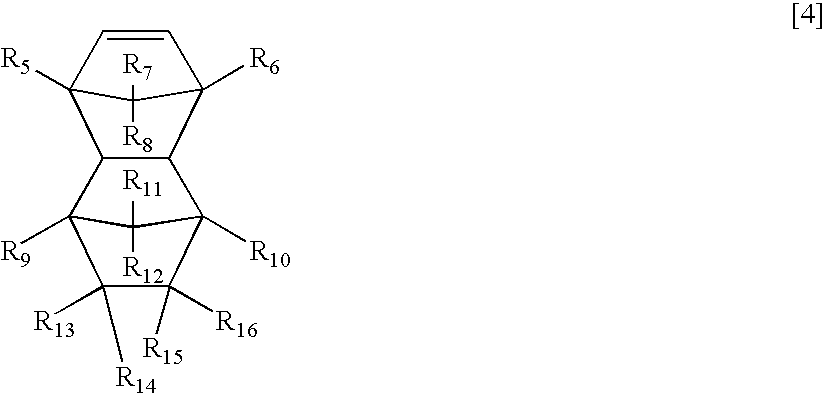Process for producing hydrogenated product of cyclic olefin polymer prepared through ring-opening polymerization
a technology of cyclic olefin and polymerization, which is applied in the field of hydrogenated products of cyclic olefin polymers prepared through ring-opening polymerization, can solve the problems of troublesome separation and removal of the polymerization system, the hydrogenation reaction does not occur often to the desired extent, and the heat stability of the polymer produced through ring-opening polymerization according to this process is poor
- Summary
- Abstract
- Description
- Claims
- Application Information
AI Technical Summary
Benefits of technology
Problems solved by technology
Method used
Image
Examples
example 1
Ring-Opening Polymerization and Hydrogenation
[0090]An autoclave equipped with a stirrer was charged with 110 parts of cyclohexane as a solvent, 21.0 parts of dicyclopentadiene and 9.0 parts of 8-ethyltetracyclododecene, and 0.17 part of 1-hexene as a molecular weight modifier. Then, 0.099 part of dichlorotris (triphenylphosphine)ruthenium, 0.029 part of tricyclohexylphosphine and 0.124 part of trimethylsilyldiazomethane were incorporated in 10 ml of toluene whereby they are allowed to react with each other to give a catalyst solution. The catalyst solution was added into the above-mentioned autoclave and polymerization was carried out at 60° C. for 1 hour. Then, 2.76 parts of ethyl vinyl ether was added to terminate the polymerization. The molecular weight of the obtained polymer was measured by GPC. The polymer had a number average molecular weight (Mn) of 12,500 and a weight average molecular weight (Mw) of 29,500, as expressed in terms of that of polystyrene.
[0091]Thereafter, add...
example 2
Ring-Opening Polymerization and Hydrogenation
[0093]The polymerization procedures as described in Example 1 were repeated wherein 15.0 parts of tetracyclododecene and 15.0 parts of norbornene were used as cyclic olefins, 0.17 part of 1-hexene was used as a molecular weight modifier, and a solution prepared by dissolving 0.059 part of bis(1,3-diisopropyl-imidazol-2-ylidene)benzylideneruthenium dichloride in 10 ml of toluene was used as a polymerization catalyst. All other conditions remained the same as in Example 1.
[0094]The resultant polymer had a number average molecular weight (Mn) of 14,100 and a weight average molecular weight (Mw) of 32,200, as expressed in terms of that of polystyrene.
[0095]Thereafter, 3.0 parts of 5% Pd / alumina catalyst was added as a hydrogenation catalyst, and hydrogenation reaction was carried out at a hydrogen pressure of 10 kg / cm2and a temperature of 150° C. for 5 hours. After the completion of reaction, the reaction liquid was cooled and filtered by a f...
example 3
Ring-Opening Polymerization and Hydrogenation
[0097]The polymerization procedures as described in Example 1 were repeated wherein 15.0 parts of dicyclopentadiene and 15.0 parts of norbornene were used as cyclic olefins, 0.26 part of 1-hexene was used as a molecular weight modifier, and a catalyst solution prepared by dissolving 0.017 part of bis(tricyclohexylphosphine) benzylideneruthenium dichloride in 10 ml of cyclohexane was used as a polymerization catalyst. All other conditions remained the same as in Example 1.
[0098]The resultant polymer had a number average molecular weight (Mn) of 8,400 and a weight average molecular weight (Mw) of 18,200, as expressed in terms of that of polystyrene.
[0099]Thereafter, 0.3 part of 40% Ni / diatomaceous earth catalyst was added as a hydrogenation catalyst, and hydrogenation reaction was carried out at a hydrogen pressure of 10 kg / cm2 and a temperature of 150° C. for 5 hours. After the completion of reaction, the reaction liquid was cooled and fil...
PUM
| Property | Measurement | Unit |
|---|---|---|
| Fraction | aaaaa | aaaaa |
| Percent by mass | aaaaa | aaaaa |
| Percent by mole | aaaaa | aaaaa |
Abstract
Description
Claims
Application Information
 Login to View More
Login to View More - R&D
- Intellectual Property
- Life Sciences
- Materials
- Tech Scout
- Unparalleled Data Quality
- Higher Quality Content
- 60% Fewer Hallucinations
Browse by: Latest US Patents, China's latest patents, Technical Efficacy Thesaurus, Application Domain, Technology Topic, Popular Technical Reports.
© 2025 PatSnap. All rights reserved.Legal|Privacy policy|Modern Slavery Act Transparency Statement|Sitemap|About US| Contact US: help@patsnap.com



